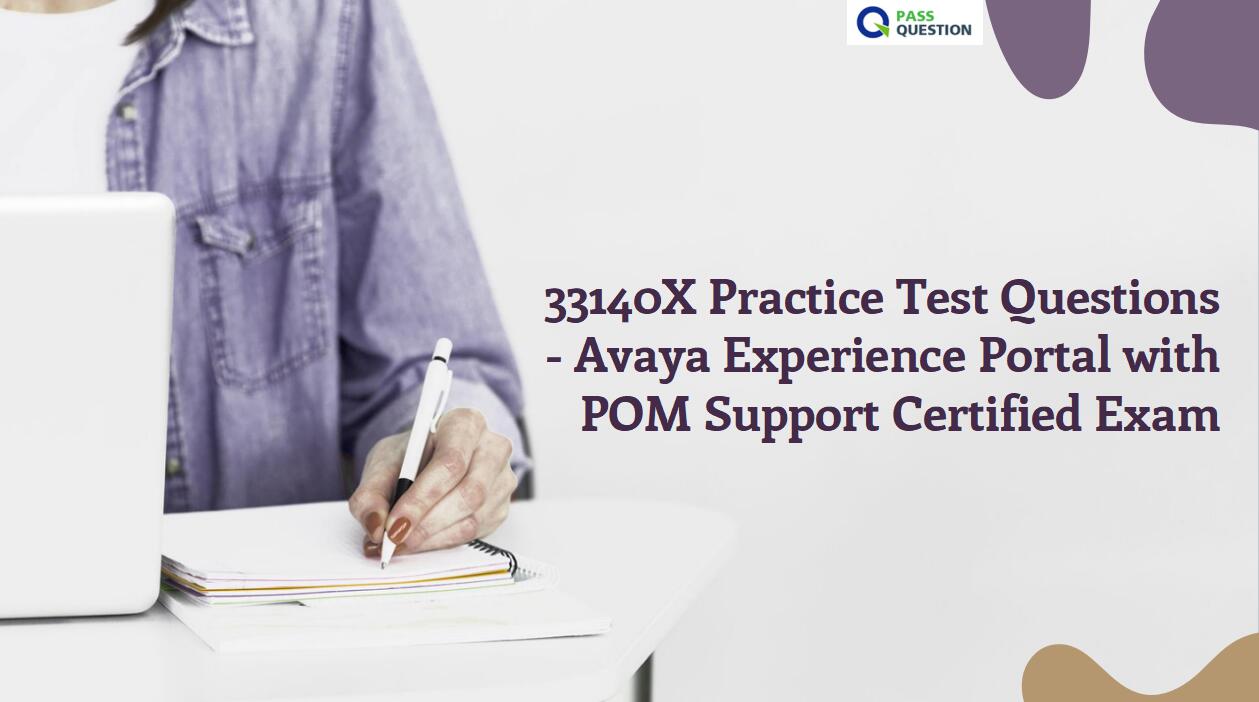The 33140X – Avaya Experience Portal with POM Support Certified Exam is critical in earning the Avaya Experience Portal with Proactive Outreach Manager Support (ACSS – 3305) credential. If you’re preparing to take this exam, the latest 33140X Practice Test Questions from PassQuestion are a game-changer. These expertly designed practice questions provide an in-depth understanding of exam topics and enhance your chances of passing on the first attempt. With PassQuestion 33140X Practice Test Questions, candidates can confidently prepare and excel in their certification journey. Use this opportunity to familiarize yourself with the exam structure, focus on weak areas, and achieve your certification goals.

33140X – Avaya Experience Portal with POM Support Certified Exam
The 33140X exam is essential for IT professionals aiming to prove their expertise in managing Avaya Experience Portal (AEP) with Proactive Outreach Manager (POM) support. Passing this exam helps candidates earn the ACSS – 3305 certification, demonstrating their proficiency in deploying, configuring, and troubleshooting AEP with POM components.
This 61-question exam assesses various aspects of the AEP and POM solutions, including architecture, installation, configuration, administration, maintenance, and troubleshooting. Candidates need to answer 40 questions correctly (66% minimum) within a 90-minute time limit to pass. Let’s take a closer look at the main topics covered in the exam.
Why Earning the ACSS – 3305 Credential Matters
Obtaining the ACSS – 3305 certification provides professionals with several career benefits. It validates your technical knowledge in AEP and POM solutions, increasing your credibility with employers and clients. Moreover, the skills gained from preparing for this exam make you more effective in managing complex communication systems.
Key Exam Topics for the 33140X Certification
Architecture
- Explain POM solution and components
- Explain AEP solution architecture and determine its solution components
- Identify the licensing requirements for AEP and POM system features and capacities
- Describe AEP deployment models and zones
Installation
- Describe the installation requirements of AEP 8.0 and POM 4.0
- Explain the features of POM and High Availability
- Describe how to install the POM database
Configuration
- Explain the basics of POM campaigns, including how to identify and schedule reports, and defining the rules
- Describe how to configure and initialize Media Processing Platform
- Describe how to configure voice, email, SMS, and Speech Server in AEP
Administration
- Explain how to set up user accounts for access to the AEP and EPM web interface
- Differentiate between the different AEP call flows
Maintenance
- Explain the required steps to back up and restore the AEP database
- Describe the maintenance procedures in the AEP system, the distribution of telephony reports, and how to apply patches on EPM and Media Processing Platform
Troubleshooting
- Describe the tools for monitoring, as well as the troubleshooting tools and logs of AEP and POM
Tips to Prepare for the 33140X Exam Using PassQuestion Practice Tests
- Focus on Weak Areas: Use practice tests to identify knowledge gaps and improve those areas.
- Simulate the Exam Environment: Practice questions in a timed setting to simulate the 90-minute exam experience.
- Study Exam Topics in Detail: Ensure you fully understand key areas like architecture, configuration, and troubleshooting.
- Use the Latest Study Materials: PassQuestion offers updated practice questions aligned with the most recent exam structure.
- Practice Troubleshooting Scenarios: Be ready for real-world scenarios by practicing with questions focused on diagnostics and issue resolution.
View Online 33140X Avaya Experience Portal with POM Support Certified Exam Free Questions
1. What aspect of AEP deployment necessitates careful consideration of network infrastructure?
A. Data security requirements
B. High availability configurations
C. Load balancing techniques
D. Real-time data transfer needs
Answer: D
2. Why should troubleshooting logs be periodically reviewed even when there are no apparent issues?
A. To prepare data for audits
B. To ensure logs are not consuming too much storage
C. To proactively identify potential problems
D. To comply with data retention policies
Answer: C
3. Which design element is critical when setting up a call flow that includes both automated and human elements in AEP?
A. Transition triggers between elements
B. Time limits on automated interactions
C. The number of redirections allowed
D. Visual prompts for user guidance
Answer: A
4. Which attributes differentiate the interactive AEP call flows from the non-interactive ones?
A. The number of users involved
B. The presence of automated response systems
C. The use of voice recognition technology
D. The need for manual intervention
Answer: D
5. What factors should be considered when setting up user accounts for access to the AEP web interface?
A. User role and permissions
B. Frequency of access
C. User’s department
D. Hardware specifications of user’s device
Answer: A
6. How should email services be configured in AEP to ensure high deliverability? (Choose Three)
A. SPF and DKIM settings
B. Server capacity planning
C. Content filtering settings
D. Email list segmentation
e) Regular updates to email templates
Answer: A, D, E
7. Why are user groups crucial in managing access permissions within the AEP web interface?
A. They provide structured data access.
B. They simplify the management of user permissions.
C. They allow for customized user interfaces.
D. They enable more efficient data processing.
Answer: B
8. Which operating systems are supported for the AEP 8.0 installation? (Choose Three)
A. Windows Server 2019
B. Linux CentOS 7
C. macOS High Sierra
D. Ubuntu 18.04 LTS
E. Solaris 11
Answer: A, B, D
9. What distinguishes the premium licensing tier for the AEP system in terms of data processing capabilities?
A. Unlimited data entry points
B. Enhanced data encryption options
C. Access to advanced analytics tools
D. Priority technical support
Answer: C
10. Why is the network zone segregation important in an AEP deployment?
A. To reduce overall system latency
B. To enhance security by isolating network traffic
C. To increase storage capacity
D. To simplify user management
Answer: B